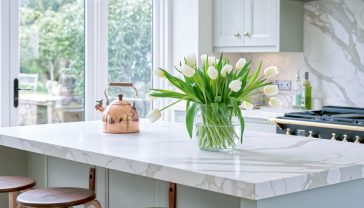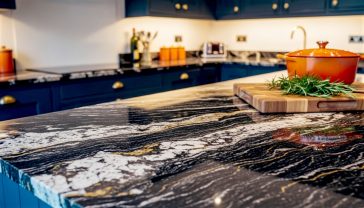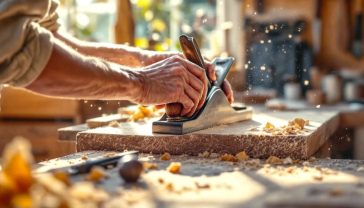The Grain of Truth: Why Sustainable Woodcraft is Shaping Britain’s Future
From ancient forests to modern eco-homes, explore the definitive guide to sustainable woodcraft and its vital role in creating a greener, healthier Britain.

This post may contain affiliate links. If you make a purchase through these links, we may earn a commission at no additional cost to you.
Picture this: you’re looking for a new coffee table. You scroll through endless online stores, seeing thousands of options. They’re cheap, they look alright, and you can have one delivered tomorrow. But have you ever stopped to wonder where that table came from? What forest was the wood from? Who made it, and what will happen to it in a few years when it breaks or goes out of fashion?
Most of the time, we don’t. We click ‘buy’ and a flat-pack box arrives. But there’s a different way, a better way. It’s a story that connects us to the ancient forests that once covered our island, to the satisfaction of making something with our own hands, and to a future where our homes are filled with beautiful things that don’t cost the earth.
This is the story of sustainable woodcraft. It’s not just about being ‘green’ or old-fashioned. It’s a modern way of living that’s about quality, health, and a real connection to the natural world. From the mighty oaks of Sherwood Forest to the sleek timber buildings rising in London, wood has always been part of Britain’s story. Now, it’s time to write the next chapter.
What on Earth is Sustainable Woodcraft, Anyway?
Let’s break it down. It sounds a bit complicated, but the idea is actually very simple.
Sustainable woodcraft is the whole journey of creating things from wood in a way that’s good for our planet, good for people, and creates products that last.
It’s not just about the final wooden chair or bookshelf. It’s about everything that happens before it gets to your home:
- The Forest: The story starts with the tree. Sustainable wood comes from forests that are managed responsibly. This means for every tree that is cut down, new ones are planted. The forest is looked after to make sure wildlife can thrive, and the whole ecosystem stays healthy. It’s the opposite of deforestation, where forests are cleared and never replaced.
- The Making: It’s about how the product is made. This often means using traditional skills and hand tools alongside modern, efficient technology. The aim is to waste as little wood as possible and to use finishes, like oils and waxes, that are natural and non-toxic, not smelly chemicals.
- The Lifespan: A sustainably made wooden item is built to last for generations, not just a few years. It can be repaired and looked after. And at the very end of its life, wood can naturally rot back into the earth or be recycled. It’s part of a circle, not a one-way trip to the landfill.
Think of it like baking a cake. You could buy a cheap, mass-produced cake from a supermarket. Or you could bake one yourself using organic flour, free-range eggs, and fruit from your garden. The second cake not only tastes better, but you also know exactly what’s in it and feel a sense of pride. Sustainable woodcraft is the second cake.
The Alphabet Soup of Green Wood: FSC and PEFC
When you’re shopping, it’s hard to know what’s truly sustainable. Luckily, there are a couple of labels to look out for that make it easier. They’re like a quality stamp for forests.
- FSC (Forest Stewardship Council): This is the big one. If you see the FSC logo, it means the wood has come from a forest that meets a strict set of environmental and social standards. They check everything, from protecting endangered animals to making sure local workers are treated fairly.
- PEFC (Programme for the Endorsement of Forest Certification): This is another major global certification. Like the FSC, it shows that the wood is from a sustainably managed forest. It’s particularly common for smaller, family-owned woodlands.
Why do these labels matter? They give you confidence. They’re proof that the wood in your product isn’t from an illegally logged ancient rainforest but from a forest that’s being cared for properly, whether it’s in the heart of Scotland or elsewhere in the world.
A Walk Through Britain’s Wooden History
To understand why sustainable woodcraft is so important now, we need to look back. Britain was once a land of trees. From the vast wildwood that covered the island after the last Ice Age, our story has been written in wood.
From Wildwood to Wooden Walls
For thousands of years, our ancestors lived in and from the woods. They built their homes from timber frames, crafted their tools from ash and yew, and cooked their food over wood fires. Great oaks were especially prized, not just for their strong timber but as sacred places.
This relationship changed as Britain grew. We needed wood for everything. We cut down forests to build the great cathedrals and to create farmland. The biggest change came with the age of sail. The Royal Navy needed thousands of mature oak trees to build a single warship—the famous ‘wooden walls’ that ruled the seas. Forests across the country, like the Forest of Dean, were stripped to build our empire. By the start of the 20th century, Britain had become one of the least forested countries in Europe. Less than 5% of our land was covered by trees.
This was a wake-up call. After the First World War, the government realised we couldn’t rely on other countries for timber. In 1919, they created the Forestry Commission with a huge mission: to replant Britain’s forests. At first, the focus was on fast-growing conifers like pine and spruce, creating massive, dark plantations. But over the last few decades, the thinking has changed. Now, the focus is on creating mixed woodlands that are good for timber, wildlife, and people.
The Ancient Craft of Working with the Woods
Long before chainsaws and sawmills, people in Britain developed clever ways of getting the wood they needed without killing the forest. These techniques are being rediscovered today because they are so sustainable.
- Coppicing: This is a brilliant method. A tree like hazel or sweet chestnut is cut down to a stump. Instead of dying, the stump (called a stool) sends up lots of new, straight stems. Every 7 to 15 years, these stems can be harvested for things like fence posts, firewood, or charcoal. The stool then grows new stems, and the cycle continues. A coppiced stool can live for hundreds of years, far longer than a normal tree, and provides a constant, reliable supply of wood. It also lets light reach the forest floor, which is fantastic for wildflowers like bluebells and wood anemones. You can still see ancient coppiced woodlands in places like the South Downs and Kent.
- Pollarding: This is similar to coppicing, but the tree is cut higher up, about six to ten feet from the ground. Why? To stop hungry animals like deer and cattle from eating the tasty new shoots! You often see pollarded willows along riverbanks and ancient beeches in historic parks and forests, like Epping Forest near London.
These traditional crafts show that people have known how to live with forests sustainably for centuries. It’s not a new idea; we’re just remembering the old wisdom.
Why Should We Care? The Real Impact of Choosing Wood
So, we know what it is and where it came from. But why does sustainable woodcraft matter so much in our busy, modern lives? The benefits are huge, touching everything from the global climate to our own happiness.
1. It’s a Secret Weapon Against Climate Change
We all hear about carbon footprints. Well, wood has a special superpower: it’s a carbon store.
As a tree grows, it breathes in carbon dioxide (CO2) from the air—one of the main gases causing climate change. It uses the carbon to build its trunk, branches, and leaves, and releases the oxygen back for us to breathe. When a tree is harvested and the wood is used to make a piece of furniture, that carbon stays locked up inside the wood for the entire life of the product.
Now, compare that to other materials:
- Plastic: Made from oil, a fossil fuel. Making plastic releases huge amounts of CO2.
- Steel and Concrete: Both need incredibly high temperatures to be produced, which also pumps out enormous amounts of CO2.
Using sustainably sourced wood instead of these materials in buildings and products is one of the easiest ways to fight climate change. A well-managed forest acts like a giant, permanent carbon-sucking factory. The young, growing trees absorb CO2 quickly, and the finished wooden products keep it locked away safely in our homes.
2. It Makes Our Homes and Minds Healthier
Have you ever noticed how you feel more relaxed when you’re walking in a park or a forest? Humans have a deep, built-in connection to nature. Scientists call this biophilia. Bringing natural materials like wood into our homes, schools, and offices taps into this connection and makes us feel better.
Studies have shown that having wood around can:
- Lower stress and blood pressure: The visual texture and warmth of wood are calming.
- Improve concentration: An office with wooden furniture can help people focus better.
- Boost our mood: It just feels good to be surrounded by natural, authentic materials.
This is the idea behind biophilic design. It’s about creating buildings that connect us to nature, and wood is the star player. Think of spaces with exposed wooden beams, timber cladding, and solid wood furniture. They feel different—warmer, more welcoming, and more human.
Furthermore, sustainable woodcraft avoids nasty chemicals. Many cheap, mass-produced furniture items are made from particleboard or MDF, which are basically wood dust and chips glued together. These glues can release chemicals called VOCs (Volatile Organic Compounds) into the air in your home for years. Solid, sustainably sourced wood finished with natural oils or waxes doesn’t do this. It’s a healthier choice for you and your family.
3. It Supports British Jobs and Communities
When you buy a piece of furniture made from locally sourced, sustainable British wood, you’re not just getting a beautiful object. You’re supporting a whole chain of local people.
You’re supporting the foresters who manage the woodlands, the small-scale sawmill that cuts the timber, the craftsperson who designs and builds the piece, and the local shop that sells it. It keeps skills alive and money in our local communities. This is a world away from buying a faceless product shipped halfway around the world in a container ship. It helps build a stronger, more resilient local economy.
Putting It Into Practice: Your Guide to Living with Sustainable Wood
This all sounds great, but how do you actually make it part of your life? It’s easier than you think. You don’t have to become a woodworking expert overnight (unless you want to!).
How to Be a Smart Buyer
When you’re looking for a new wooden product, whether it’s a dining table, a chopping board, or even a garden shed, here’s what to look for:
- Check for the Label: Look for the FSC or PEFC logo. This is your simplest guarantee of sustainability.
- Ask Questions: Don’t be afraid to ask the seller where the wood comes from. A passionate, genuine maker will be proud to tell you the story of their materials. If they don’t know or seem evasive, that’s a red flag.
- Choose Solid Wood: Whenever you can, choose solid wood over veneered particleboard or MDF. It’s stronger, lasts longer, can be repaired if it gets scratched or dented, and it doesn’t contain the same chemical glues.
- Think Local: Look for makers and companies that use British-grown timber. Woods like oak, ash, beech, and cherry are beautiful, durable, and native to our country. Buying local reduces the ‘wood miles’ and supports our own woodland economies. (Note: Due to the devastating effects of Ash Dieback disease, the use of British ash is now a complex issue, often focused on using wood from trees that have to be felled for safety).
- Consider Reclaimed Wood: Reclaimed timber, salvaged from old buildings or furniture, is a fantastic sustainable option. It’s already been harvested, and it often has a unique character and history that you can’t get with new wood.
Getting Hands-On: The Joy of Making
One of the best ways to appreciate sustainable woodcraft is to try it yourself. The maker movement has seen a huge revival in craft skills across the UK. It’s incredibly satisfying to take a simple piece of wood and turn it into something useful and beautiful.
- Start Small: You don’t need a massive workshop. A simple project like carving a spoon (a craft known as whittling or slöjd) can be done with just a couple of small, safe knives.
- Find a Course: There are amazing woodworking courses all over the UK. You can learn anything from traditional green woodworking (using freshly cut wood) and furniture making to woodturning. It’s a great way to learn skills and meet like-minded people.
- Use Reclaimed Materials: A brilliant starting point is to use reclaimed wood. Old pallets (make sure they are stamped ‘HT’ for heat-treated, not ‘MB’ for chemically treated), scaffolding boards, or bits of old furniture can be transformed with a bit of sanding and creativity.
Working with your hands connects you to the material in a powerful way. It slows you down and makes you focus. In our screen-obsessed world, it’s a form of mindfulness that leaves you with something real to show for it at the end.
The Future is Wooden: Building a Better Britain
The story of woodcraft is far from over. In fact, it might be the key to our future. Architects and engineers are rediscovering wood as a super-material for the 21st century.
New technologies are allowing us to build huge structures out of wood. Cross-Laminated Timber (CLT) is a great example. It’s made by gluing layers of wood together at right angles, creating massive, incredibly strong panels. These panels are as strong as steel or concrete but are five times lighter and lock up huge amounts of carbon.
Architects are now using CLT to build everything from schools and apartment blocks to skyscrapers, right here in the UK. A building made of wood is not only better for the planet, but it’s also a healthier and more pleasant place to live or work.
But there are challenges. We need to plant more forests—the right kind of forests, with a mix of species that are resilient to climate change and diseases like ash dieback. We need to invest in training a new generation of foresters, craftspeople, and builders who have the skills to work with wood sustainably.
And most of all, we need to change our mindset. We need to move away from a throwaway culture to one where we value things that are made to last. We need to see furniture not as disposable fashion, but as companions for life—objects that gather memories and can be passed down through generations.
Choosing sustainable woodcraft is about more than just buying a table. It’s a vote for healthy forests, for a stable climate, for skilled craftspeople, and for a deeper connection to the material world. It’s a simple, beautiful, and powerful choice that can help us build a better, more sustainable future, one piece of wood at a time.
Further Reading:
- Forestry England: Discover and explore the nation’s forests.
- The Woodland Trust: The UK’s largest woodland conservation charity, working to protect and create native woodlands.
- Grown in Britain: A movement that promotes the use of British-grown timber.
- The Sylva Foundation: A charity helping Britain’s trees and woodlands thrive for people and for nature.
- The Heritage Crafts Association: A charity that supports and champions traditional heritage crafts in the UK, including many forms of woodcraft.






